Air New Zealand: Outsourcing Maintenance - ANZES Case Study Analysis
VerifiedAdded on 2022/09/21
|5
|944
|20
Case Study
AI Summary
This assignment analyzes the Air New Zealand case study regarding the outsourcing of its wide-body aircraft maintenance operations. The case examines the inefficiencies of Air New Zealand Engineering Services (ANZES) due to its limited customer base and geographical disadvantages, which hinder the achievement of economies of scale. The analysis explores the cost implications of maintaining wide-body aircraft, the benefits of outsourcing maintenance to reduce costs and improve profitability, and the potential drawbacks, such as loss of control and potential quality issues. The document highlights the pros and cons of outsourcing, including the minimization of cash outflow and the risk of delayed deliveries, and concludes that outsourcing is a viable strategy for Air New Zealand to improve its financial performance. References to relevant sources such as The Economist and Forbes are also included.
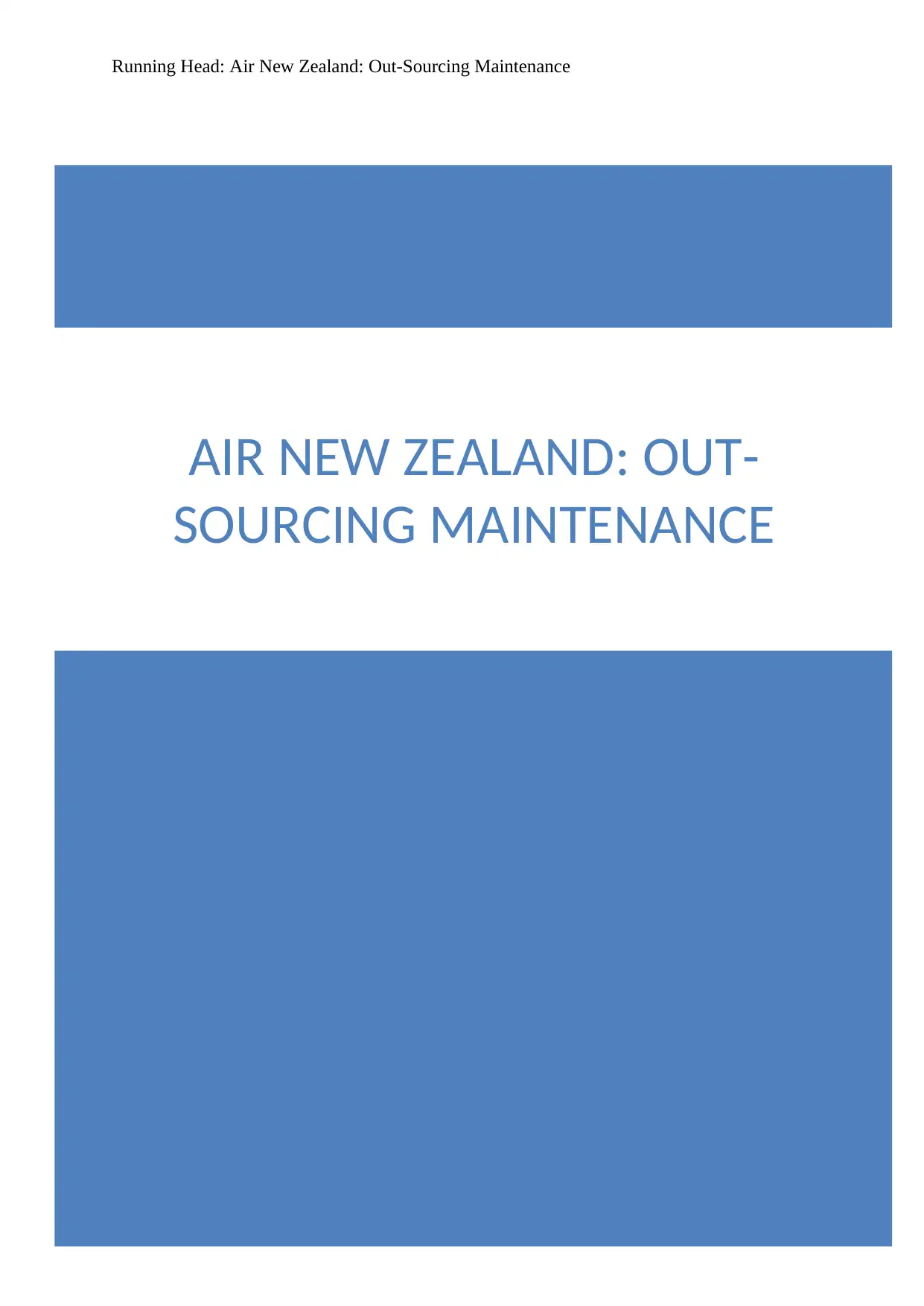
AIR NEW ZEALAND: OUT-
SOURCING MAINTENANCE
Running Head: Air New Zealand: Out-Sourcing Maintenance
SOURCING MAINTENANCE
Running Head: Air New Zealand: Out-Sourcing Maintenance
Paraphrase This Document
Need a fresh take? Get an instant paraphrase of this document with our AI Paraphraser
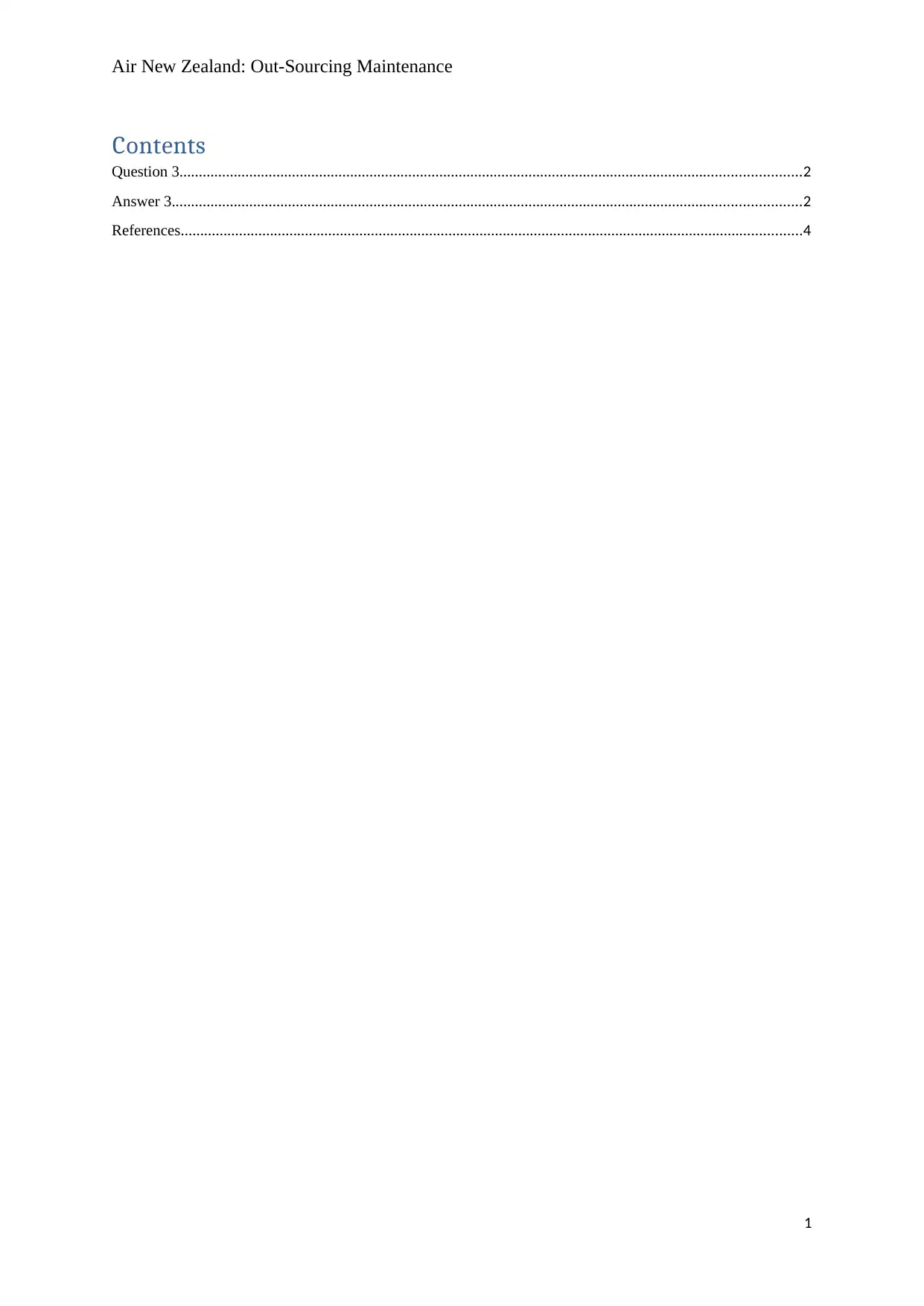
Air New Zealand: Out-Sourcing Maintenance
Contents
Question 3................................................................................................................................................................2
Answer 3..................................................................................................................................................................2
References................................................................................................................................................................4
1
Contents
Question 3................................................................................................................................................................2
Answer 3..................................................................................................................................................................2
References................................................................................................................................................................4
1
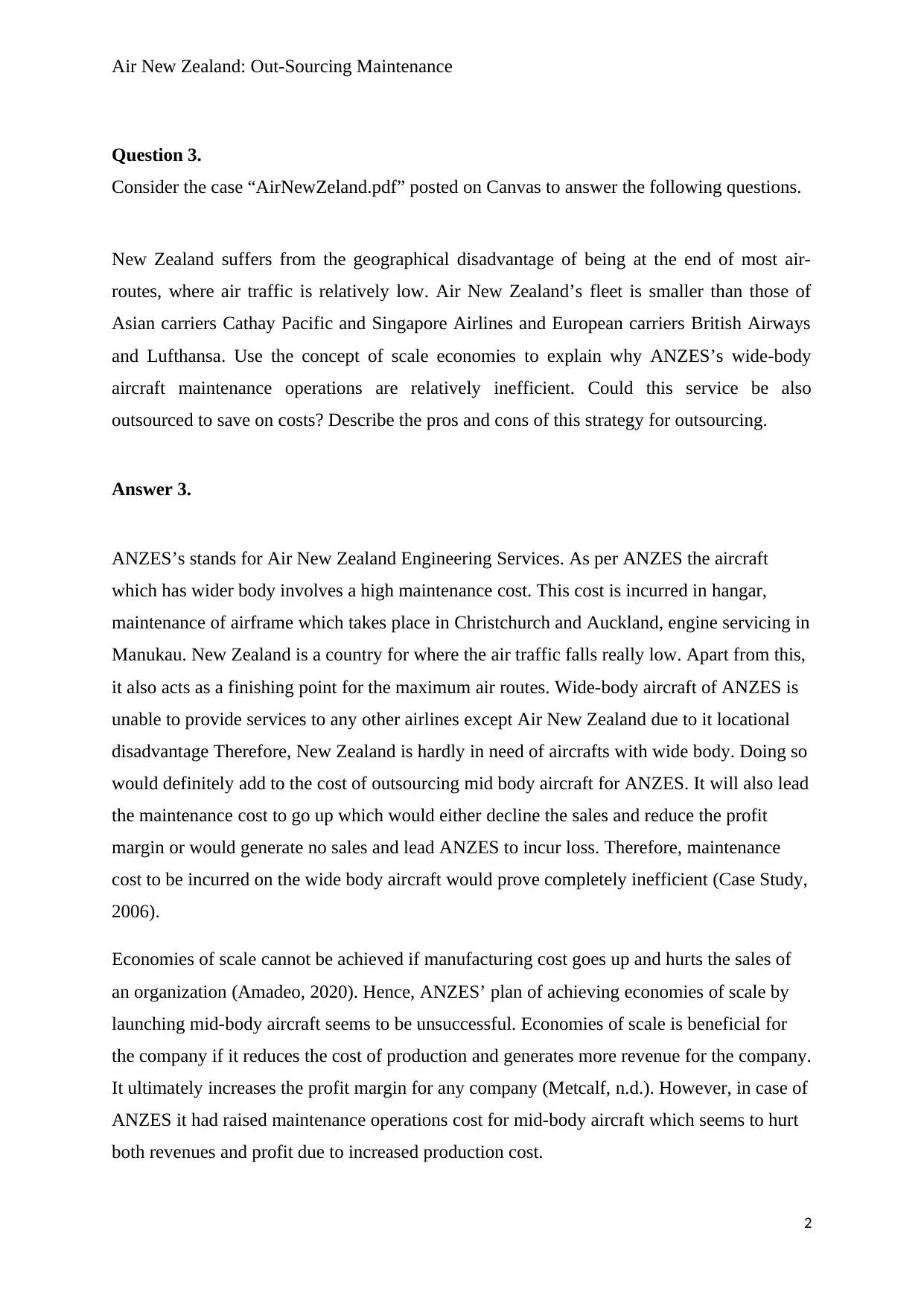
Air New Zealand: Out-Sourcing Maintenance
Question 3.
Consider the case “AirNewZeland.pdf” posted on Canvas to answer the following questions.
New Zealand suffers from the geographical disadvantage of being at the end of most air-
routes, where air traffic is relatively low. Air New Zealand’s fleet is smaller than those of
Asian carriers Cathay Pacific and Singapore Airlines and European carriers British Airways
and Lufthansa. Use the concept of scale economies to explain why ANZES’s wide-body
aircraft maintenance operations are relatively inefficient. Could this service be also
outsourced to save on costs? Describe the pros and cons of this strategy for outsourcing.
Answer 3.
ANZES’s stands for Air New Zealand Engineering Services. As per ANZES the aircraft
which has wider body involves a high maintenance cost. This cost is incurred in hangar,
maintenance of airframe which takes place in Christchurch and Auckland, engine servicing in
Manukau. New Zealand is a country for where the air traffic falls really low. Apart from this,
it also acts as a finishing point for the maximum air routes. Wide-body aircraft of ANZES is
unable to provide services to any other airlines except Air New Zealand due to it locational
disadvantage Therefore, New Zealand is hardly in need of aircrafts with wide body. Doing so
would definitely add to the cost of outsourcing mid body aircraft for ANZES. It will also lead
the maintenance cost to go up which would either decline the sales and reduce the profit
margin or would generate no sales and lead ANZES to incur loss. Therefore, maintenance
cost to be incurred on the wide body aircraft would prove completely inefficient (Case Study,
2006).
Economies of scale cannot be achieved if manufacturing cost goes up and hurts the sales of
an organization (Amadeo, 2020). Hence, ANZES’ plan of achieving economies of scale by
launching mid-body aircraft seems to be unsuccessful. Economies of scale is beneficial for
the company if it reduces the cost of production and generates more revenue for the company.
It ultimately increases the profit margin for any company (Metcalf, n.d.). However, in case of
ANZES it had raised maintenance operations cost for mid-body aircraft which seems to hurt
both revenues and profit due to increased production cost.
2
Question 3.
Consider the case “AirNewZeland.pdf” posted on Canvas to answer the following questions.
New Zealand suffers from the geographical disadvantage of being at the end of most air-
routes, where air traffic is relatively low. Air New Zealand’s fleet is smaller than those of
Asian carriers Cathay Pacific and Singapore Airlines and European carriers British Airways
and Lufthansa. Use the concept of scale economies to explain why ANZES’s wide-body
aircraft maintenance operations are relatively inefficient. Could this service be also
outsourced to save on costs? Describe the pros and cons of this strategy for outsourcing.
Answer 3.
ANZES’s stands for Air New Zealand Engineering Services. As per ANZES the aircraft
which has wider body involves a high maintenance cost. This cost is incurred in hangar,
maintenance of airframe which takes place in Christchurch and Auckland, engine servicing in
Manukau. New Zealand is a country for where the air traffic falls really low. Apart from this,
it also acts as a finishing point for the maximum air routes. Wide-body aircraft of ANZES is
unable to provide services to any other airlines except Air New Zealand due to it locational
disadvantage Therefore, New Zealand is hardly in need of aircrafts with wide body. Doing so
would definitely add to the cost of outsourcing mid body aircraft for ANZES. It will also lead
the maintenance cost to go up which would either decline the sales and reduce the profit
margin or would generate no sales and lead ANZES to incur loss. Therefore, maintenance
cost to be incurred on the wide body aircraft would prove completely inefficient (Case Study,
2006).
Economies of scale cannot be achieved if manufacturing cost goes up and hurts the sales of
an organization (Amadeo, 2020). Hence, ANZES’ plan of achieving economies of scale by
launching mid-body aircraft seems to be unsuccessful. Economies of scale is beneficial for
the company if it reduces the cost of production and generates more revenue for the company.
It ultimately increases the profit margin for any company (Metcalf, n.d.). However, in case of
ANZES it had raised maintenance operations cost for mid-body aircraft which seems to hurt
both revenues and profit due to increased production cost.
2
⊘ This is a preview!⊘
Do you want full access?
Subscribe today to unlock all pages.

Trusted by 1+ million students worldwide
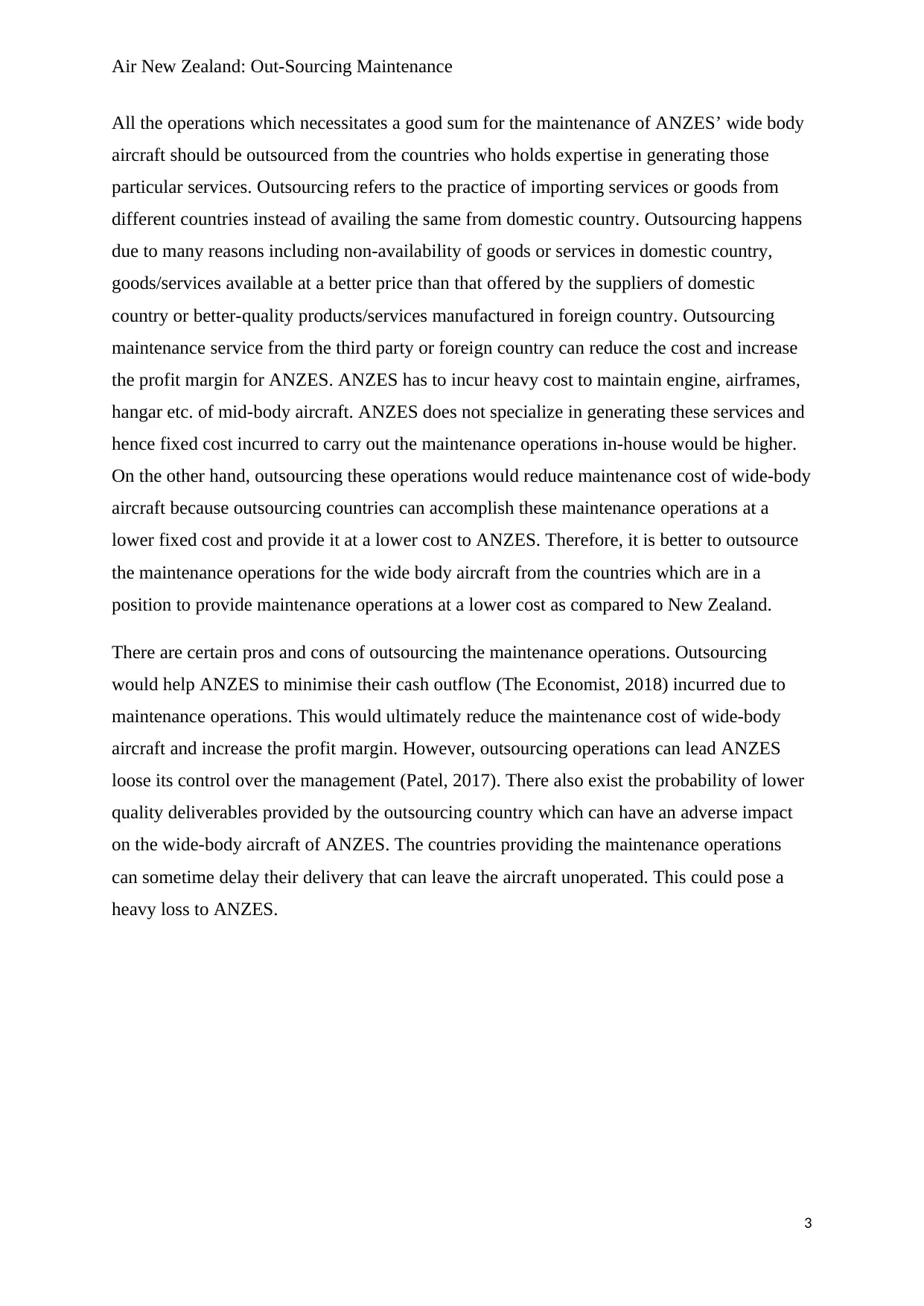
Air New Zealand: Out-Sourcing Maintenance
All the operations which necessitates a good sum for the maintenance of ANZES’ wide body
aircraft should be outsourced from the countries who holds expertise in generating those
particular services. Outsourcing refers to the practice of importing services or goods from
different countries instead of availing the same from domestic country. Outsourcing happens
due to many reasons including non-availability of goods or services in domestic country,
goods/services available at a better price than that offered by the suppliers of domestic
country or better-quality products/services manufactured in foreign country. Outsourcing
maintenance service from the third party or foreign country can reduce the cost and increase
the profit margin for ANZES. ANZES has to incur heavy cost to maintain engine, airframes,
hangar etc. of mid-body aircraft. ANZES does not specialize in generating these services and
hence fixed cost incurred to carry out the maintenance operations in-house would be higher.
On the other hand, outsourcing these operations would reduce maintenance cost of wide-body
aircraft because outsourcing countries can accomplish these maintenance operations at a
lower fixed cost and provide it at a lower cost to ANZES. Therefore, it is better to outsource
the maintenance operations for the wide body aircraft from the countries which are in a
position to provide maintenance operations at a lower cost as compared to New Zealand.
There are certain pros and cons of outsourcing the maintenance operations. Outsourcing
would help ANZES to minimise their cash outflow (The Economist, 2018) incurred due to
maintenance operations. This would ultimately reduce the maintenance cost of wide-body
aircraft and increase the profit margin. However, outsourcing operations can lead ANZES
loose its control over the management (Patel, 2017). There also exist the probability of lower
quality deliverables provided by the outsourcing country which can have an adverse impact
on the wide-body aircraft of ANZES. The countries providing the maintenance operations
can sometime delay their delivery that can leave the aircraft unoperated. This could pose a
heavy loss to ANZES.
3
All the operations which necessitates a good sum for the maintenance of ANZES’ wide body
aircraft should be outsourced from the countries who holds expertise in generating those
particular services. Outsourcing refers to the practice of importing services or goods from
different countries instead of availing the same from domestic country. Outsourcing happens
due to many reasons including non-availability of goods or services in domestic country,
goods/services available at a better price than that offered by the suppliers of domestic
country or better-quality products/services manufactured in foreign country. Outsourcing
maintenance service from the third party or foreign country can reduce the cost and increase
the profit margin for ANZES. ANZES has to incur heavy cost to maintain engine, airframes,
hangar etc. of mid-body aircraft. ANZES does not specialize in generating these services and
hence fixed cost incurred to carry out the maintenance operations in-house would be higher.
On the other hand, outsourcing these operations would reduce maintenance cost of wide-body
aircraft because outsourcing countries can accomplish these maintenance operations at a
lower fixed cost and provide it at a lower cost to ANZES. Therefore, it is better to outsource
the maintenance operations for the wide body aircraft from the countries which are in a
position to provide maintenance operations at a lower cost as compared to New Zealand.
There are certain pros and cons of outsourcing the maintenance operations. Outsourcing
would help ANZES to minimise their cash outflow (The Economist, 2018) incurred due to
maintenance operations. This would ultimately reduce the maintenance cost of wide-body
aircraft and increase the profit margin. However, outsourcing operations can lead ANZES
loose its control over the management (Patel, 2017). There also exist the probability of lower
quality deliverables provided by the outsourcing country which can have an adverse impact
on the wide-body aircraft of ANZES. The countries providing the maintenance operations
can sometime delay their delivery that can leave the aircraft unoperated. This could pose a
heavy loss to ANZES.
3
Paraphrase This Document
Need a fresh take? Get an instant paraphrase of this document with our AI Paraphraser
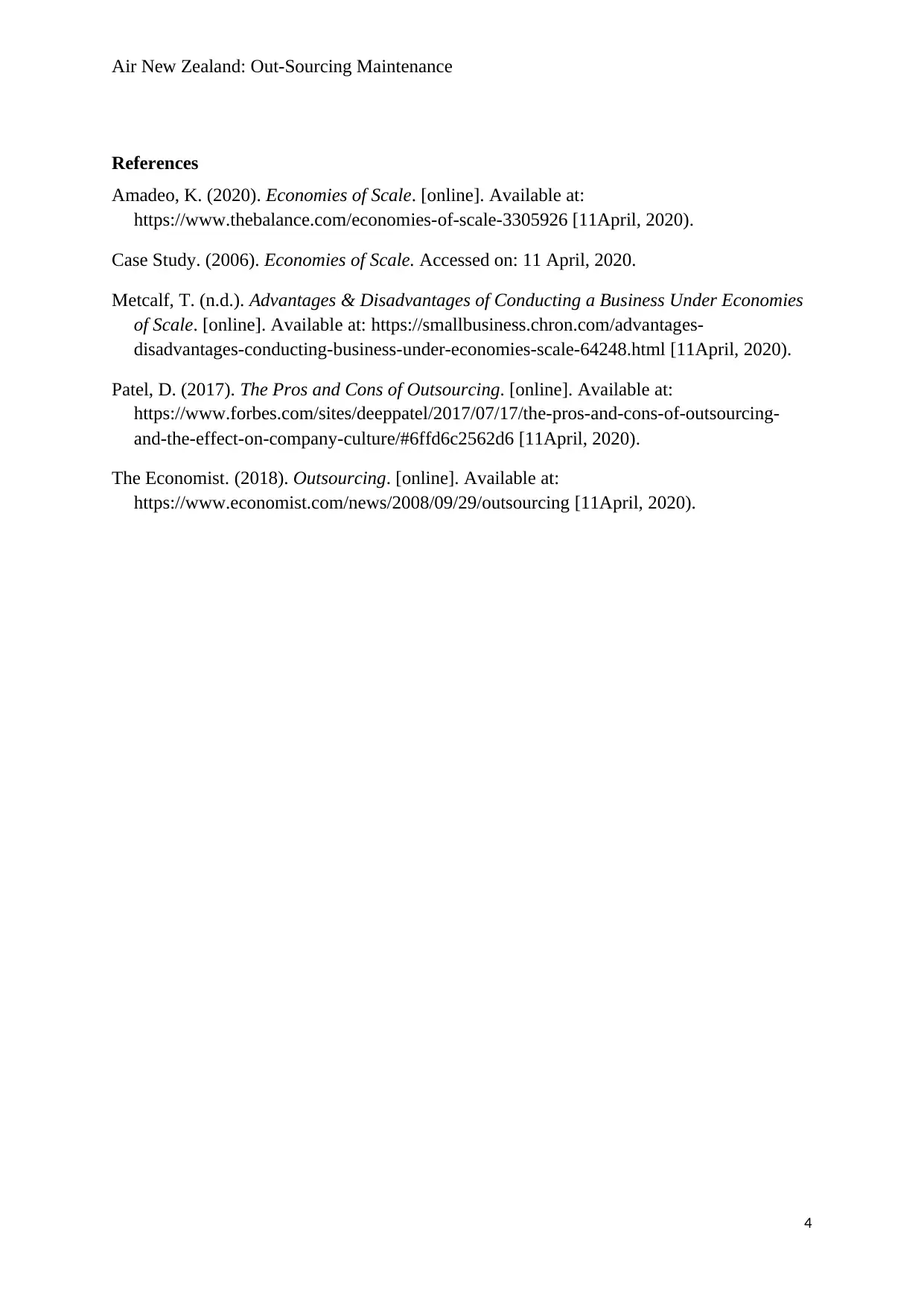
Air New Zealand: Out-Sourcing Maintenance
References
Amadeo, K. (2020). Economies of Scale. [online]. Available at:
https://www.thebalance.com/economies-of-scale-3305926 [11April, 2020).
Case Study. (2006). Economies of Scale. Accessed on: 11 April, 2020.
Metcalf, T. (n.d.). Advantages & Disadvantages of Conducting a Business Under Economies
of Scale. [online]. Available at: https://smallbusiness.chron.com/advantages-
disadvantages-conducting-business-under-economies-scale-64248.html [11April, 2020).
Patel, D. (2017). The Pros and Cons of Outsourcing. [online]. Available at:
https://www.forbes.com/sites/deeppatel/2017/07/17/the-pros-and-cons-of-outsourcing-
and-the-effect-on-company-culture/#6ffd6c2562d6 [11April, 2020).
The Economist. (2018). Outsourcing. [online]. Available at:
https://www.economist.com/news/2008/09/29/outsourcing [11April, 2020).
4
References
Amadeo, K. (2020). Economies of Scale. [online]. Available at:
https://www.thebalance.com/economies-of-scale-3305926 [11April, 2020).
Case Study. (2006). Economies of Scale. Accessed on: 11 April, 2020.
Metcalf, T. (n.d.). Advantages & Disadvantages of Conducting a Business Under Economies
of Scale. [online]. Available at: https://smallbusiness.chron.com/advantages-
disadvantages-conducting-business-under-economies-scale-64248.html [11April, 2020).
Patel, D. (2017). The Pros and Cons of Outsourcing. [online]. Available at:
https://www.forbes.com/sites/deeppatel/2017/07/17/the-pros-and-cons-of-outsourcing-
and-the-effect-on-company-culture/#6ffd6c2562d6 [11April, 2020).
The Economist. (2018). Outsourcing. [online]. Available at:
https://www.economist.com/news/2008/09/29/outsourcing [11April, 2020).
4
1 out of 5
Your All-in-One AI-Powered Toolkit for Academic Success.
+13062052269
info@desklib.com
Available 24*7 on WhatsApp / Email
![[object Object]](/_next/static/media/star-bottom.7253800d.svg)
Unlock your academic potential
Copyright © 2020–2025 A2Z Services. All Rights Reserved. Developed and managed by ZUCOL.
